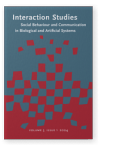Vol. 5:1 (2004) ► pp.3–44
Towards robot cultures?
Learning to imitate in a robotic arm test-bed with dissimilarly embodied agents
The study of imitation and other mechanisms of social learning is an exciting area of research for all those interested in understanding the origin and the nature of animal learning in a social context. Moreover, imitation is an increasingly important research topic in Artificial Intelligence and social robotics which opens up the possibility of individualized social intelligence in robots that are part of a community, and allows us to harness not only individual learning by the single robot, but also the acquisition of new skills by observing other members of the community (robots, humans, or virtual agents). After an introduction to the main research issues in research on imitation in various fields (including psychology, biology and robotics), we motivate the particular focus of this work, namely the correspondence problem. We describe Action Learning for Imitation via Correspondences between Embodiments (Alice), an implemented generic framework for solving the correspondence problem between differently embodied robots. Alice enables a robotic agent to learn a behavioral repertoire suitable to performing a task by observing a model agent. Importantly, the model agent could possibly possess a different type of body, e.g. a different number of limbs or joints (implying different degrees of freedom), a different height, different sensors, a different basic action repertoire, etc. Previously, in a test-bed where the agents differed according to their possible movement patterns, we demonstrated that the character of imitation achieved will depend on the granularity of subgoal matching, and on the metrics used to evaluate success.
In our current work, we implemented Alice in a new test-bed called Rabit where simple simulated robotic arm agents use various metrics for evaluating success according to actions, states, effects, or weighted combinations.
We examine the roles of synchronization, looseness of perceptual matching, and of proprioceptive matching by a series of experiments. Also, we study how Alice copes with changes in the embodiment of the imitator during learning. Our simulation results suggest that synchronization and loose perceptual matching allow for faster acquisition of behavioral compentencies at low error rates.
Social learning (broadly construed) plays a role as a replication mechanism for behaviors and results in variability when the transmitted behavior differs from the model’s behavior, thus providing the evolutionary substrate for culture and its pre-cursors. Social learning in robotics could therefore serve as the basis for culture in societies whose members include artificial agents. We address the use of imitative social learning mechanisms like Alice for transmission of skills between robots, and give first examples of transmission of a skill despite differences in embodiment of agents involved. In the particular setup, transmission occurs through a chain, as well as emerging in cyclic arrangements of robots. These simple examples demonstrate that by using social learning and imitation, (proto-)cultural transmission is possible among robots, even in heterogeneous groups of robots.
Cited by (15)
Cited by 15 other publications
This list is based on CrossRef data as of 4 july 2024. Please note that it may not be complete. Sources presented here have been supplied by the respective publishers. Any errors therein should be reported to them.
